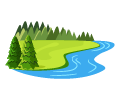Wildlife in Managed Forests

FOREST TYPES FOR EVERY WILDLIFE HABITAT.
One of the primary focus points of forest management is creating and maintaining wildlife habitat by having a mosaic of forest types on the landscape.

WILDLIFE NEED BOTH YOUNGER AND OLDER FORESTS.
Young forest types with open canopy provide habitat for migratory songbirds and pollinators and provide forage for deer and elk and hunting ground for birds of prey. Older forest types provide cover for wildlife to rest and nesting opportunities for birds who rely on closed canopy forests.

PROTECTION FOR FOREST STREAMS AND RIVERS.
Forest management also protects forest streams that provide habitat for aquatic species like beaver and salamanders and critical spawning areas for salmon and other native fish.